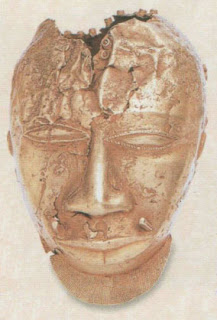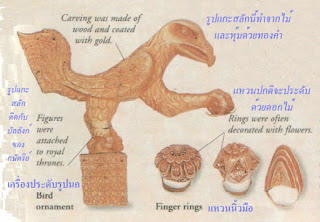HISTORY OF AFRICA
CIVILIZATION IN
AFRICA BEGAN TO appear more than 5,000 years ago with
the rise of ancient Egypt. From about 2,500 years ago in
sub-Saharan Africa, many other
different kingdoms also developed. The Sahara
acted as a barrier to keep this area separate from the rest
of the world until the arrival of Arab traders in the 8th century. From the 15th century, the
arrival of Europeans, the subsequent slave trade, and
European imperialism had a profound effect on the
continent. Since the 1950s, all African
nations have reclaimed independence, although modern
Africa continues to struggle with its post-colonial legacy and environmental problems.
|
ประวัติศาสตร์แอฟริกา
อารยธรรมในทวีปแอฟริกาเริ่มปรากฏขึ้นมากกว่า
5,000 ปีที่ผ่านมาเมื่ออียิปต์โบราณปรากฏขึ้น ตั้งแต่ประมาณ 2,500 ปีที่ผ่านมา ในแอฟริกาใต้สะฮารา
มีราชอาณาจักรอื่น ๆ ต่าง ๆ
มากมายที่ยังมีวิวัฒนาการอยู่ ทะเลทรายสะฮาทำหน้าที่เป็นแนวกั้นเขตแดนทำให้บริเวณนี้แยกออกจากส่วนอื่นของโลกจนกระทั่งพ่อค้าชาวอาหรับดินทางมาถึงในศตวรรษที่
8 นับตั้งแต่ศตวรรษที่ 15 ชาวยุโรปเดินทางมาถึง ก็มีการค้าขายทาสตามมา
และลัทธิจักรวรรดินิยมของยุโรปก็มีผลกระทบอย่างถ้วนทั่วบนทวีปนั้น ตั้งแต่ทศวรรษที่
1650 ชาติแอฟริกาทั้งหมดก็เรียกร้องอิสรภาพกลับคืน แม้ว่าแอฟริกาสมัยใหม่ยังคงดินรนต่อสู้กับมรดกที่เกิดขึ้นภายหลังลัทธิจักรวรรดินิยม
และปัญหาสิ่งแวดล้อม
|
||||||||||
Early
inhabitants
Humans have inhabited
Africa for 4 million years. The Sahara was once a
fertile land rich in plants and animals. But
thousands of years ago, it dried up, and people moved
south to the savannah to farm there.
|
ผู้คนที่อาศัยอยู่ในยุคแรก
มนุษย์อาศัยอยู่ในทวีปแอฟริกามาเป็นเวลา
4 ล้านปีแล้ว ครั้งหนึ่ง ทะเลทรายสะฮาราเป็นดินแดนที่อุดมสมบูรณ์และมีพืชมีสัตว์มากมาย
แต่เมื่อหลายพันปีที่ผ่านมา ก็เกิดความแห้งแล้งและผู้คนก็อพยพจากทางใต้ไปสู่ทุ่งหญ้าสะวันนาเพื่อทำมาหากิน
ณ ที่นั่น
|
||||||||||
Rock paintings
Rock and bone
pictures often depicted everyday events,
such as dancing, hunting animals, and fishing. Painters used animal fat colored with
vegetable dyes.
|
ภาพเขียนบนหิน
ปกติภาพวาดบนหินและกระดูกจะอธิบายเหตุการณ์ในชีวิตประจำวัน
เช่น การเต้นรำ การล่าสัตว์ และการตกปลา จิตรกรจะใช้ไขมันสัตว์ทำสีผสมกับสีพืช
|
||||||||||
Nok culture
The earliest evidence
of Iron Age settlement is called the Nok
culture (500 BC-AD 200), which existed in what is now central Nigeria. Nok people lived in farming communities. They made
iron weapons and tools for farming, and also produced fine terracotta sculptures.
|
อารยธรรมนก
หลักฐานชิ้นแรกสุดของการตั้งหลักแหล่งในยุคหินเรียกว่า
อารยธรรมนก (500 ปีก่อนคริสตกาล – ค.ศ.
200) ซึ่งยังหลงเหลือในประเทศไนจีเรียตอนกลางในปัจจุบัน ชาวนกอาศัยเป็นสังคมเกษตรกรรม
ทำอาวุธและเครื่องมือจากเหล็กสำหรับทำเกษตรกรรม และยังผลิตประติมากรรมจากดินเผาสีอิฐสวยสดงดงามด้วย
|
||||||||||
Aksum
From c.300,
Egyptian scholars introduced Christianity to Aksum, which then became famous as a holy city. During this period, Aksum took over the
empire based at Meroe. Aksum's
people built tall, stone stelae (monuments) to mark the tombs of dead kings.
อักซุม
นับตั้งแต่ศตวรรษที่
300 นักวิชาการชาวอียิปต์ได้นำศาสนาคริสต์ไปเผยแพร่ยังอักซุม ซึ่งต่อมาก็กลายเป็นเมืองอันศักดิ์สิทธิ์ที่มีชื่อเสียง
ในช่วงเวลานี้ อักซุมเข้าควบคุมจักรวรรดิมีฐานอยู่ที่เมโร ประชาชนของอักซุมได้สร้างแผ่นศิลาจารึกหินสูง
(เป็นอนุสารีย์) เพื่อเป็นเครื่องหมายสุสานของกษัตริย์ที่สวรรคต
|
|
Spread of religions
From the 8th century,
trade, conquests, and colonialism spread religions such as Islam in Africa. In North Africa, Islam completely replaced traditional religions,
which often included the worship of ancestors.
|
|
การเผยแพร่ศาสนา
นับตั้งแต่ศตวรรษที่
8 การค้าขาย การพิชิต และลัทธิล่าอาณานิคมได้เผยแพร่ศาสนา เช่น
ศาสนาอิสลาในแอฟริกา ในแอฟริกาเหนือ ศาสนาอิสลามเข้ามาแทนที่ศาสนาเก่าแก่โดยปกติก็คือการบูชานับถือบรรพบุรุษอย่างสมบูรณ์แบบ
|
|||||
|
Ancestor worship
In many parts of
Africa, communities had sacred shrines where they placed
offerings for the spirits of their dead ancestors. Today, during certain annual festivals,
members of the community wear special masks, sing,
dance, and tell stories in honor of their ancestors.
|
|
การบูชานับถือบรรพบุรุษ
ในหลาย
ๆ ส่วนของทวีปแอฟริกา
ชุมชนจะมีวิหารศักดิ์สิทธิ์ที่สำหรับถวายเครื่องเซ่นไว้ให้กับดวงวิญญาณของบรรพบุรุษที่ล่วงลับไปแล้ว
ปัจจุบัน ในช่วงระหว่างเทศกาลประจำปีบางเวลา
สมาชิกของชุมชนจะสวมหน้ากากพิเศษมาร้องรำทำเพลง เต้นรำและเล่าเรื่องราวต่าง ๆ
เพื่อถวายเกียรติยศให้กับบรรพบุรุษของตนเอง
|
|
||||
|
Ait
Benhaddou, Morocco
เอท เบนฮัดโด โมร็อกโก
|
|
Islam
By c.800,
Middle Eastern Arabs had taken Islam to North
Africa. From the 11th century,
trade helped spread Islam across the Sahara into West Africa and up the River Nile
into Sudan.
|
|
อิสลาม
ประมาณศตวรรษที่
800 ชาติอาหรับในตะวันออกกลางได้นำศาสนาอิสลามไปยังแอฟริกาเหนือ นับตั้งแต่ศตวรรษที่
11 การค้าขายได้ช่วยเผยแพร่ศาสนาอิสลาข้ามทะเลทรายสะฮาราไปยังแอฟริกาตะวันตกและขึ้นไปตามแม่น้ำไนล์ไปยังประเทศซูดาน
|
|||
|
Slave trade
By the 1470s, the
Portuguese were trading copper, brass, gold, and slaves
with Benin in West Africa. In the
1480s, the Portuguese arrived in the islands of Principe
and Sao Tome in the Gulf of Guinea, just off the west African coast. They established
sugar plantations, and forced African captives (mainly kidnapped in Senegal and Gambia) to work as slaves on the plantations. This
was the beginning of European domination in Africa.
|
|
การค้าขายทาส
ประมาณทศวรรษที่
1470 ชาวโปรตุเกสกำลังค้าขายทองแดง ทองเหลือง ทองคำ และทาสกับประเทศเบนิน ในแอฟริกาตะวันตก
ในทศวรรษที่ 1480 ชาวโปรตุเกสได้เดินทางมาถึงหมู่เกาะปรินซีปีและเซาตูเมในอ่าวกินี
ใกล้ชายฝั่งแอฟริกาตะวันตก พวกเขาสร้างสวนน้ำตาลและบังคับชาวแอฟริกันเชลย (ส่วนใหญ่ถูกลักพาตัวไปไว้ในเซเนกัลและแกมเบีย)
เพื่อทำงานเป็นทาสในพื้นที่เพาะปลูก นี่คือจุดเริ่มต้นของยุโรปเข้าครอบงำแอฟริกา
|
|
||||










